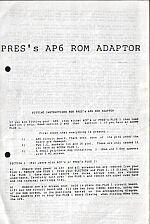
Electron User
 1st May 1988
1st May 1988
Categories: Review: Peripheral
Author: Chris Nixon
Publisher: ACP/Pres
Machine: Acorn Electron
Published in Electron User 5.08
When Acorn first designed the Electron it was always intended to be capable of supporting up to 16 ROMs at once, just like the BBC Micro. Therefore the BBC Micro's Operating System was duplicated (almost) in full on the Electron ready for this eventuality, despite the fact that the standard machine was provided with no spare ROM sockets.
So it wasn't until the release of the Acorn Plus 1 that ROMs could be added to the Electron, and then only by the use of ROM cartridges. And these were - and still are - relatively expensive. Additionally, only two dual-ROM cartridges could be inserted into the Plus 1 at one time.
Since then several companies have produced Sideways ROM and RAM boards to fill the gap left by the rather limited Acorn Plus 1/AP1 - you'll find a full review of them in the February 1987 issue of Electron User.
At one time a separate external ROM board was available, but the manufacturers have since ceased production. This has left Slogger providing possibly the only Electron ROM board, in the form of its own version of the Plus 1, the Rombox+.
Now, for the first time, comes the Advanced Plus 6, or AP6 - a unit which not only allows up to six ROMs to be inserted into the board, but will also accept RAM chips in any of the sockets.
Standard static RAM chips can be bought cheaply and fitted into the sockets exactly as if they were ROMs. This provides the ability to load ROM iages from discs into the RAM chips - known as Sideways RAM when used in this fashion - as and when needed.
Here they will be treated as physical ROMs by the Electron and, once loaded, ROM images will remain in RAM until the power is turned off. (It's worth noting that the extra RAM can't be used for BASIC programs.)
This allows you, in effect, much more than just the Electron's 16 ROM maximum, without having to physically insert and remove ROM chips - a potentially damaging task if repeated frequently on the same ROMs.
What's more, Sideways RAM provides the perfect environment for writing your own ROMs, if you are so inclined.
This isn't as difficult as you may think - anyone with a smattering of 6502 machine code knowledge can write a ROM, using some of the many books on the subject as tutorials. In fact, we published an article on how to write your own ROM in the February 1986 issue of Electron User.
The AP6 is quite a breakthrough for its designers, Pres, and as the unit is mounted unobtrusively inside an existing Acorn Plus 1/AP1 it reduces the number of gadgets hanging off the back of your Electron. The only snag is that you must already have an ADVANCED PLUS 1 from Pres in which to place the AP6. Owners of the original Acorn Plus 1 will have to either set soldering iron to PCB to make the necessary alterations, or they can add £7 (plus VAT) to their order for a complete upgrade service. Of course the old Acorn Plus 1 must be posted with your order if going for the upgrade.
The unit is a marvellous piece of design: strong, neat and compact, and it won't crowd the Plus 1 to the point of overheating. Each socket is easily accessed with a screwdriver for removing ROMs, unlike some boards where delicate capacitors always seem to be in the way.
Using Static RAM chips in place of ROM/EPROMs is achieved by simply inserting them in any of the sockets, but they must be 32K chips rather than the cheaper 8K ones.
The AP6 worked perfectly and I was able to use all my Electron ROMs indiscriminately in any of the sockets, with no problems.
One point worth noting: If you have the Acorn Plus 3, only five of the six sockets will be available for other ROMs. Owners of ACP's own disc interfaces will not be affected, as these sit in the Plus 1 cartridge slots.
Coming soon from Pres is the AP7. This is an enhancement for the AP6 which will provide two 16K banks of Battery-Backed Sideways RAM with full write-protect option.
This will mean that while the write-protect is on, ROM images will remain in the machine after the power is switched off, and will be - to all intents and purposes - permanent ROMs.
Some links on the AP6 board are provided in readiness for the AP7, and these are simply changed over when you fit the new board.
Overall, the AP6 is an excellent unit, providing for the first time in one package all the aspects of Sideways ROM and RAM expansion facilities your Electron needs. Together with the AP7, the AP6 will make your Electron just about as powerful in the Sideways ROM/RAM department as can be imagined.
If you are a serious Electron user and don't already have the facilities provided by the AP6 in other forms, don't hesitate - buy it!


